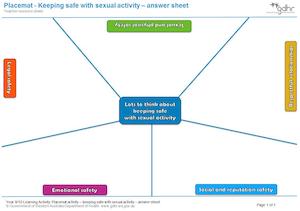 Say:
Say:
"In this video there are some words and phrases that need some thinking about and discussing before we get to see the video."
 Divide the class into groups to discuss the following questions. Ask for responses from each group.
Divide the class into groups to discuss the following questions. Ask for responses from each group.
❓ What do you think 'ramification' means? Use a dictionary if you don't know.
(Consequence, result, aftermath, outcome, effect.)
❓ Thinking about the topic of 'staying safe in a sexual situation' - what do you think would be covered in a 'proper talk'?
(e.g., Communicating about individual wants; consent; STI and pregnancy prevention.)
❓ What do you understand 'safe sex' measures to be?
(Using a condom to prevent STIs and/or pregnancy and using a contraceptive method to prevent pregnancy.)
 Explain:
Explain:
"The term 'safe sex' and 'safer sex' are often used interchangeably. In this video the term 'safe sex' is used, however, the more accurate term is 'safer sex' as no sexual activity is 100% safe."
For a more detailed explanation see Safer sex (external link) and What is safer sex? (external link).
- Watch Laugh and learn - keeping safe (2min 8sec)

 Ask:
Ask:
❓ What do you think of the use of humour in this video?
❓ Does it help get information across? How?
❓ What is the message/information you got from this video?
(e.g. it is important to talk about safer sex beforehand; both partners need to be ready; the age of consent in WA is 16; partners should be aware of what each other want; consent is vital)
 Say:
Say:
"While humour is useful and we can laugh at some aspects, there is a serious side to keeping safe that we need to look at. We're going to look at some of the important considerations around, and possible 'ramifications' (consequences) of, sexual activity."
 Ask:
Ask:
❓ There were a number of positive key words you may have seen or heard in the video. What were they? (Give clues by writing these words with some letters missing.)
- communicate/communication/talk
- consent
- comfort/comfortable
- conversation
- wants/expectations
❓ So why is it important to talk about safe sex beforehand?
(e.g., ready; comfortable; can be difficult because it is out of comfort zone; both need to be aware of each others expectations.)
 Say:
Say:
"There are several aspects to keeping safe in sexual situations that need to be considered.
There are different areas that need to be considered when people are thinking about keeping themselves and their partners safe in sexual situations. As we have discussed, safety and wellbeing related to sexual activity is about more than just STI and pregnancy prevention. It is important to think about the issues and and impacts related to all areas:
- physical (including sexual health)
- emotional
- social
- respectful relationship with partner
- the law
Many of the issues and consequences considered in each area overlap and link with other areas.
- As a whole group, revise the legal aspects of consent in WA (legal age of consent in WA is 16; consent must be mutual, freely given, informed, certain, coherent, clear and ongoing; consent can be withdrawn at any time).
 Teaching tip: For essential information about consent, safer sex and taking selfies go to the Youth Law Australia website (external site) and Get the Facts - Sex and the law (external site).
Teaching tip: For essential information about consent, safer sex and taking selfies go to the Youth Law Australia website (external site) and Get the Facts - Sex and the law (external site).
Teaching strategy: Placemat activity
In groups of 4 students complete Student activity sheet: Keeping safe with sexual activity. Have each group discuss and record possible issues and ramifications associated with different aspects of keeping safe in sexual situations:
- physical (including sexual health)
- emotional
- social
- respectful relationship with partner
- the law

- Have groups share ideas with the whole class. See Teacher resource: Placemat activity_answer sheet for possible answers.

- Remind students that the Sexual Assault Resource Centre (SARC) is a free service available for people who have experienced sexual assault. Display the SARC website and crisis line phone numbers (08) 6458 1828 or free call 1800 199 888. Posters can be put up in class and other places around the school.

![]() Say:
Say: Ask students:
Ask students:![]() Teaching tip: It is important not to tell students who their trusted adults are or should be. You can offer a list of suggestions of who they might be. For some students, some of the people you suggest, may not be people that are safe for them to talk to. Students should not be made to share their list of trusted adults publicly unless they wish to do so.
Teaching tip: It is important not to tell students who their trusted adults are or should be. You can offer a list of suggestions of who they might be. For some students, some of the people you suggest, may not be people that are safe for them to talk to. Students should not be made to share their list of trusted adults publicly unless they wish to do so.







